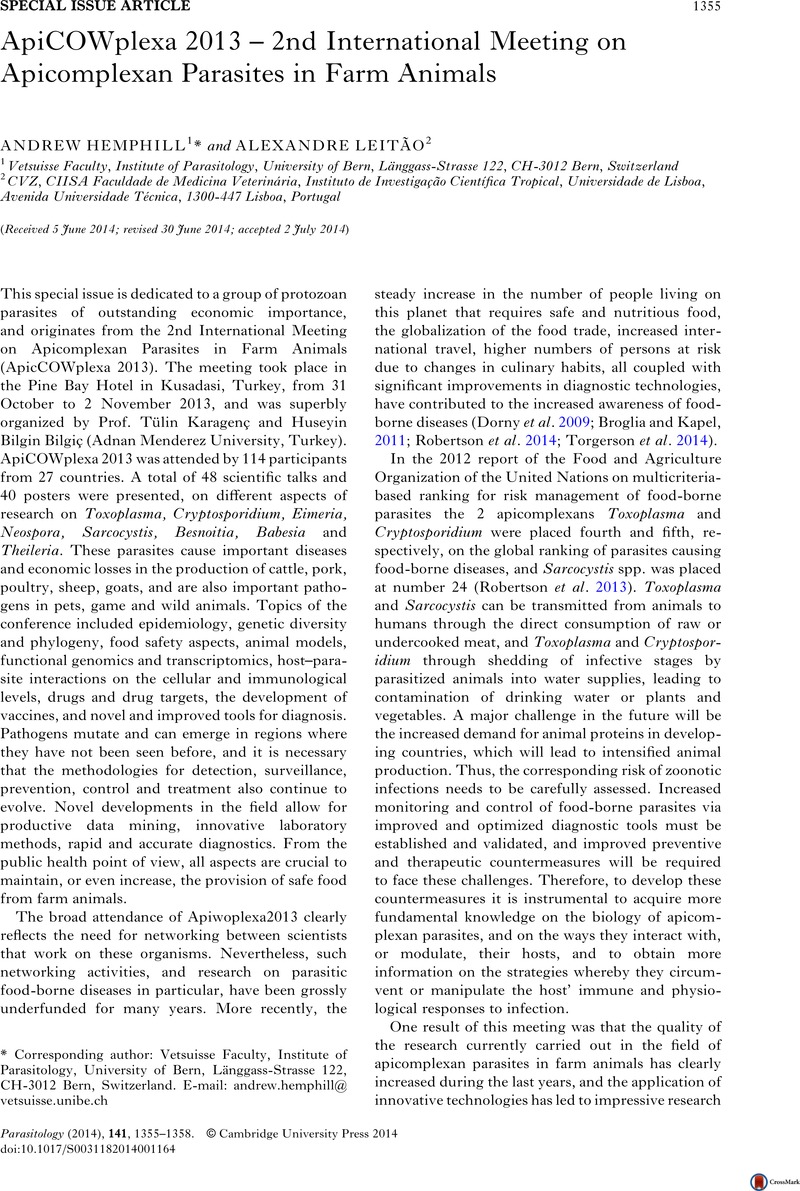No CrossRef data available.
Article contents
ApiCOWplexa 2013 – 2nd International Meeting on Apicomplexan Parasites in Farm Animals
Published online by Cambridge University Press: 19 August 2014
Abstract
An abstract is not available for this content so a preview has been provided. Please use the Get access link above for information on how to access this content.

- Type
- Special Issue Article
- Information
- Parasitology , Volume 141 , Special Issue 11: ApiCOWplexa 2013 – 2nd International Meeting on Apicomplexan Parasites in Farm Animals , September 2014 , pp. 1355 - 1358
- Copyright
- Copyright © Cambridge University Press 2014
References
REFERENCES
Álvarez-García, G., Garcia-Lunar, P., Gutierrez Exposito, D., Shkap, V. and Ortega-Mora, L. M. (2014). Dynamics of Besnoitia besnoiti infection in cattle. Parasitology
141, 1419–1435.CrossRefGoogle ScholarPubMed
Benavides, J., Collantes-Fernández, E., Ferre, I., Pérez, V., Campero, C., Mota, R., Innes, E. and Ortega-Mora, L. M. (2014). Experimental ruminant models for bovine neosporosis: what is known and what is needed. Parasitology
141, 1471–1488.CrossRefGoogle ScholarPubMed
Broglia, A. and Kapel, C. (2011). Changing dietary habits in a changing world: emerging drivers for the transmission of foodborne parasitic zoonoses. Veterinary Parasitology
182, 2–13.CrossRefGoogle Scholar
Cardoso, R., Nolasco, S., Goncalves, J., Cortes, H. C., Leitao, A. and Soares, H. (2014).
Besnoitia besnoiti and Toxoplasma gondii: two apicomplexan 1 strategies to manipulate the host cell centrosome and Golgi apparatus. Parasitology
141, 1436–1454.CrossRefGoogle Scholar
Cortes, H. C., Leitao, A., Gottstein, B. and Hemphill, A. (2014). A review on bovine besnoitiosis: a disease with economic impact in herd health management, caused by Besnoitia
besnoiti (Franco and Borges, 1916). Parasitology
141, 1406–1417.CrossRefGoogle Scholar
Dangoudoubiyam, S., Zhang, Z. and Howe, D. K. (2014). Purine salvage in the apicomplexan Sarcocystis neurona, and generation of hypoxanthine xanthine–guanine phosphoribosyltransferase-deficient clones for positive–negative selection of transgenic parasites. Parasitology
141, 1399–1405.CrossRefGoogle ScholarPubMed
Dorny, P., Praet, N., Deckers, N. and Gabriel, S. (2009). Emerging food-borne parasites. Veterinary Parasitology
163, 196–206.CrossRefGoogle ScholarPubMed
Geuthner, A.-C., Koethe, M., Ludewig, M., Pott, S., Schares, G., Daugschies, A. and Bangoura, B. (2014). Persistence of Toxoplasma gondii tissue stages in poultry over a conventional fattening cycle. Parasitology
141, 1359–1364.CrossRefGoogle Scholar
Hermosilla, D., Munoz Caro, T., Silva, L. M. R., Ruiz, A. and Taubert, A. (2014). The intriguing host innate immune response: novel anti-parasitic defence by neutrophil extracellular traps. Parasitology
141, 1489–1498.CrossRefGoogle ScholarPubMed
Hiszczyńska-Sawicka, E., Gatkowska, J. M., Grzybowski, M. and Długońska, H. (2014). Veterinary vaccines against toxoplasmosis. Parasitology
141, 1365–1378.CrossRefGoogle ScholarPubMed
Jiménez-Ruiz, E., Wong, E. H., Pall, G. S. and Meissner, M. (2014). Advantages and disadvantages of conditional 1 systems for characterisation of essential genes in Toxoplasma gondii
. Parasitology
141, 1390–1398.CrossRefGoogle Scholar
Keyloun, K. R., Reid, M. C., Choi, R., Song, Y., Fox, A. M. W., Hillesland, H. K., Zhang, Z., Vidadala, R., Merrith, E. A., Lau, A. O. T., Maly, D. J., Fan, E., Barret, L. K., Van Voorhis, W. C. and Ojo, K. K. (2014). The gatekeeper residue and beyond: homologous calcium dependent protein kinases as drug development targets for veterinarian Apicomplexa parasites. Parasitology
141, 1499–1509.CrossRefGoogle ScholarPubMed
Lendner, M., Daugschies, A. (2014).
Cryptosporidium infections: molecular advances. Parasitology
141, 1511–1532.CrossRefGoogle ScholarPubMed
Reichel, M. P., McAlliser, M. M., Pomro, W. E., Campero, C., Ortega-Mora, L. M. and Ellis, J. T. (2014). Control options for Neospora caninum – is there anything new or are we going backwards?
Parasitology
141, 1455–1470.CrossRefGoogle ScholarPubMed
Robertson, L. J., van der Giessen, J. W., Batz, M. B., Kojima, M. and Cahill, S. (2013). Have foodborne parasites finally become a global concern?
Trends in Parasitology
29, 101–103.CrossRefGoogle ScholarPubMed
Robertson, L. J., Sprong, H., Ortega, Y. R., van der Giessen, J. W. and Fayer, R. (2014). Impacts of globalisation on foodborne parasites. Trends in Parasitology
30, 37–52.CrossRefGoogle ScholarPubMed
Torgerson, P. R., de Silva, N. R., Fevre, E. M., Kasuga, F., Rokni, M. B., Zhou, X. N., Sripa, B., Gargouri, N., Willingham, A. L. and Stein, C. (2014). The global burden of foodborne parasitic diseases: and update. Trends in Parasitology
30, 1–52.CrossRefGoogle ScholarPubMed
Witcombe, D. M. and Smith, N. C. (2014). Strategies for anti-coccidial prophylaxis. Parasitology
141, 1379–1389.CrossRefGoogle ScholarPubMed


